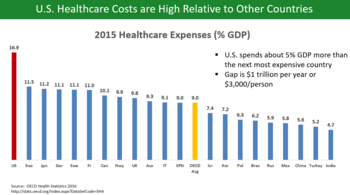Universal health protection indicates that all individuals have access to the health services they require, when and where they require them, without financial hardship. It consists of the complete series of necessary health services, from health promo to avoidance, treatment, rehabilitation, and palliative care. Currently, at least half of individuals worldwide do not get the health services they require.
This need to change. To make health for all a truth, we need: individuals and neighborhoods who have access to high quality health services so that they take care of their own health and the health of their families; competent health workers supplying quality, people-centred care; and policy-makers devoted to purchasing universal health coverage.
Health systems are rooted in the neighborhoods they serve. They focus not only on preventing and dealing with disease and disease, however likewise on assisting to enhance well-being and quality of life. what is health care policy.
Universal healthcare is a system that offers quality medical services to all citizens. The federal government uses it to everyone no matter their ability to pay. The large expense of supplying quality health care makes universal health care a large expense for federal governments. The majority of universal health care is funded by basic earnings taxes or payroll taxes.
But its health shipment system does have particular elements, such as Medicare, Medicaid, and the Department of Veterans Affairs, that supply universal health care to specific populations. Reduces general health care expenses: The government controls the costs through settlement and guideline. Reduces administrative expenses: Physicians only handle one government agency.
doctors invest 4 times as much as Canadians dealing with insurance provider. Forces health centers and physicians to offer the same requirement of service at a low cost: In a competitive environment like the United States, healthcare suppliers need to likewise concentrate on earnings. They do this by providing the cutting edge.
The 30-Second Trick For With Respect To A Worker's Health-care Coverage
They attempt to contend by targeting the rich. Develops a much healthier workforce: Research studies show that preventive care decreases the https://johnnyznlt233.godaddysites.com/f/how-how-does-health-care-policy-making-operate-in-the-united-stat need for costly emergency situation space usage. Without access to preventive care, 46% of emergency situation space patients went because they had no other location to go. They utilized the emergency space as their main care physician.
Early childhood care prevents future social costs: These consist of criminal offense, welfare dependence, and health concerns. Health education teaches families how to make healthy way of life choices, avoiding persistent diseases. Federal governments can enforce regulations and taxes to direct the population toward healthier options: Laws make unhealthy choices, such as drugs, illegal. Sin taxes, such as those on cigarettes and alcohol, make them more costly.
The sickest 5% of the population produce 50% of overall health care costs, while the healthiest 50% just create 3% of expenses. Individuals have less monetary incentive to stay healthy: Without a copay, people might overuse emergency rooms and physicians. There are long wait times for optional treatments: The federal government focuses on offering basic and emergency situation health care.
Health care costs. For instance, some Canadian provinces invest practically 40% of their budget plans on healthcare. with a low likelihood of success. This includes drugs for rare conditions and pricey end-of-life care. In the United States, take care of patients in the last six years of life comprises one-fourth of the Medicare budget plan.
Standardizes service. Develops a healthier labor force. Avoids future social expenses. Guides individuals to make healthier options. Downsides Healthy people pay for the sickest. Individuals have less financial incentive to stay healthy. Long wait times. Physicians might cut care to reduce costs. Healthcare expenses overwhelm government budgets. The government may limit services that have a low probability of success There are 3 universal healthcare designs.
Countries typically combine universal health coverage with other systems to introduce competition. These choices can decrease expenses, broaden option, or enhance care. Citizens can also select better services with extra private insurance. The United States uses various models for populations such as the senior, veterans, and low-income people. In a single-payer system, the federal government supplies totally free healthcare spent for with income from income taxes.
The Ultimate Guide To What Is Health Care Reform
Every resident has the same access to care. This is called the Beveridge Design. When governments provide health care, they work to make sure physicians and medical facilities offer quality care at an affordable expense. They should collect and evaluate data. They can likewise use their buying power to affect healthcare suppliers.
Other countries include Spain, New Zealand, and Cuba. The United States uses it to veterans and military workers with the Department of Veterans Affairs and the militaries. Nations that use a social medical insurance design requires everybody to purchase insurance, usually through their companies. The taxes enter into a government-run health insurance coverage fund that covers everybody.
The government manages medical insurance rates. It also has a great deal of clout to manage the private-providers' costs. Germany developed this system. France, Belgium, the Netherlands, Japan and Switzerland likewise use it. The U.S. Obamacare system likewise needs insurance coverage, but there are lots of exemptions. It is also similar in that it supplies subsidies to medical insurance business for low-income enrollees.

Every citizen pays into the national insurance strategy. Administrative expenses are lower due to the fact that there is one insurer. The federal government has a great deal of take advantage of to force Substance Abuse Center medical costs down. Canada, Taiwan, and South Korea use this model. The U.S. Medicare, Medicaid, and TRICARE systems also utilize this design Australia has a blended health strategy.

Everyone receives coverage. People must pay deductibles prior to federal government payments start. Numerous citizens want to spend for extra personal health insurance to receive a greater quality of care. Government regulations protect senior citizens, the poor, children, and rural homeowners. In 2018, health care expense 9. 3% of Australia's gdp.
The per capita cost was US$ 5,005, about average for developed nations. There Drug Rehab Center were 42. 6% of clients who reported a wait time of more than 4 weeks to see an expert. Australia had one of the finest baby mortality rates of the compared countries at 3. 1%. Canada has a national medical insurance system.
Not known Facts About How Do Health Care Tax Credits Work
Private additional insurance coverage pays for vision, dental care, and prescription drugs. Hospitals are publicly funded. They offer free care to all residents no matter their capability to pay. The federal government keeps health centers on a fixed budget plan to control expenses, however reimburses physicians at a fee-for-service rate. In 2018, healthcare cost 10.
The cost per individual was US$ 4,974. A whopping 62. 8% of patients waited more than 4 weeks to see an expert. The baby death rate was 4. 3%, amongst the countries compared. France has a social health insurance coverage system that provides care to all legal locals. That consists of health centers, physicians, drugs, and some oral and vision care.
Of that, payroll taxes fund 64%, income taxes spend for 16%, and 12% is from tobacco and alcohol taxes. In 2018, health care cost 11. 2% of GDP. That was US$ 4,965 per person. Half of all clients reported a wait time of more than 4 weeks to see a professional.